|
|
MAIN RESEARCH LINES
Dynamics of magnetic structures in the solar corona
|
MHD modeling of magnetic structures of the solar corona and Coronal
Mass Ejection (CME). The studies are devoted to discover new diagnostic
tools and to acquire new insight in the detailed physics of magnetic
structures of the solar corona The project is based on the FLASH and
PLUTO codes and we performed extensive 2D and 3D MHD simulations, using
substantial resources, including those of a PRACE Project and 2 national
key-projects, at CINECA. Currently we are analysing the propagation
of high-speed chromospheric flows into coronal magnetic flux tubes,
and the possible production of emission in the EUV band (Petralia et
al. 2014, A&A submitted). Also we are investigating the heating released
by magnetic reconnection of a twisted coronal loop in the framework of
a PRACE project[ .... read more .... ].
|
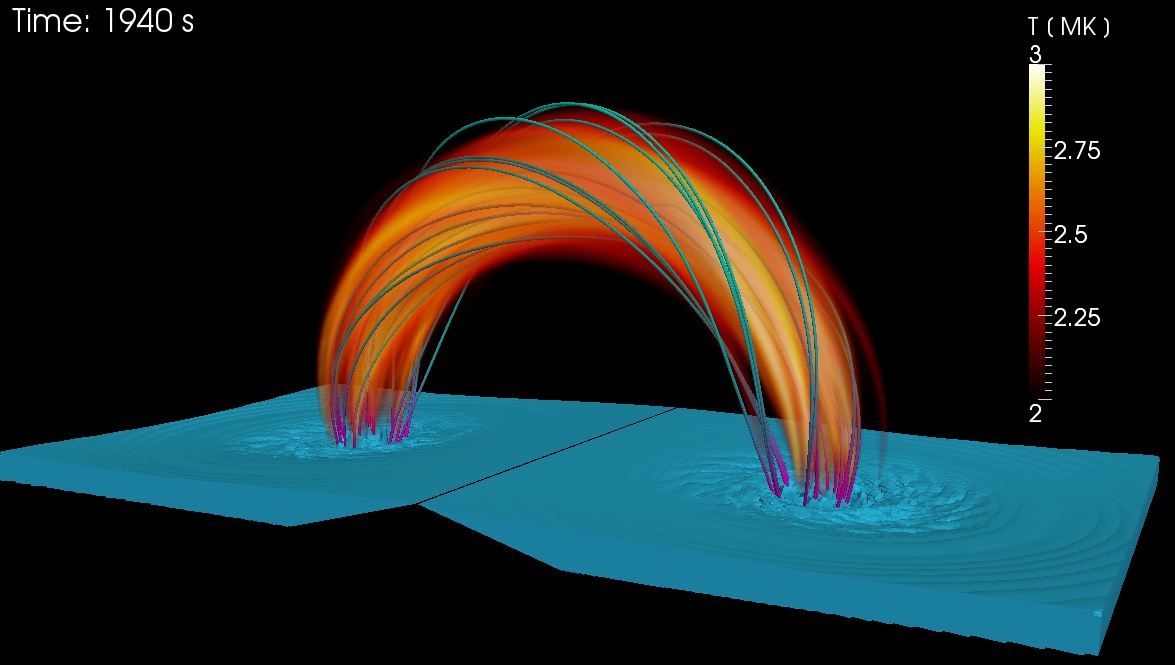 |
Physics of accretion phenomena in young stellar objects
|
Modeling of accretion streams impacting onto the surface of classical
T Tauri stars (CTTSs) with the aim to analyze the relation between the
physical and chemical properties of the accretion stream (flux velocity,
mass density and chemical abundances) and the observed X-ray spectrum
of young accreting stars. The project takes advantage of two well-tested
advanced numerical codes, namely FLASH and PLUTO. We performed extensive
1D hydrodynamic simulations (with FLASH) and 2D MHD simulations (with
PLUTO), using resources at CINECA. Our first study, aimed at investigating
the dynamics and stability of shock-heated accreting material in CTTSs,
was based on a 1D hydrodynamic model and has shown that accretion
shocks may generate an hot slab of material above the chromosphere with
temperature and mass density consistent with those observed (Sacco et
al. 2008). As a next step, we have used the same model
to investigate the observability of accretion shocks, by exploring a
wide range of physical parameters (Sacco et al. 2010). In another work
we investigated the stability and variability of accretion shocks by
means of 2D MHD simulations to evaluate the role of the stellar magnetic
field in confining the accretion column and the post-shock hot slab for
different values of the plasma-beta (Orlando et al. 2010).
|
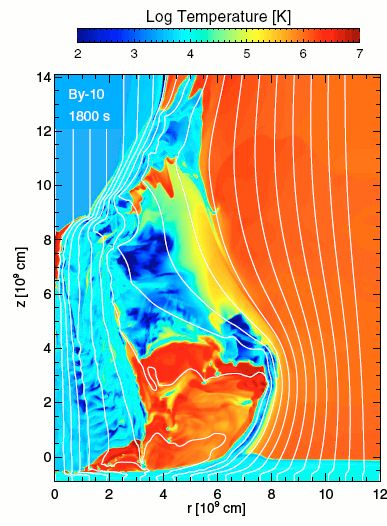 |
Flaring events in classical T Tauri stars
|
MHD modeling of flares occurring in young stellar objects (YSOs)
with the aim to investigate the effects of the flares on the stability
of the circumstellar disk surrounding the central protostar. The
project is based on the PLUTO code and we performed extensive 2D and
3D MHD simulations, using substantial resources, including those of 1
key-project, at CINECA. A first work was devoted to study the evolution
of a flare occurring close to the surface of the circumstellar disk
and its effects on the stability of the disk (Orlando et al. 2011). We
investigated the conditions under which a flare may trigger mass accretion
episodes. Recently a Class A project has been approved by ISCRA to further
investigate this issue. In particular the project aims at exploring in
more detail the possibility that significant mass accretion in young
stars can be triggered by a storm of small-to-medium flares (as those
frequently observed) occurring on the accretion disk. This study will
shed light on the nature of the phenomena driving the high levels of
coronal activity in YSOs and on their role in the accretion processes.
|
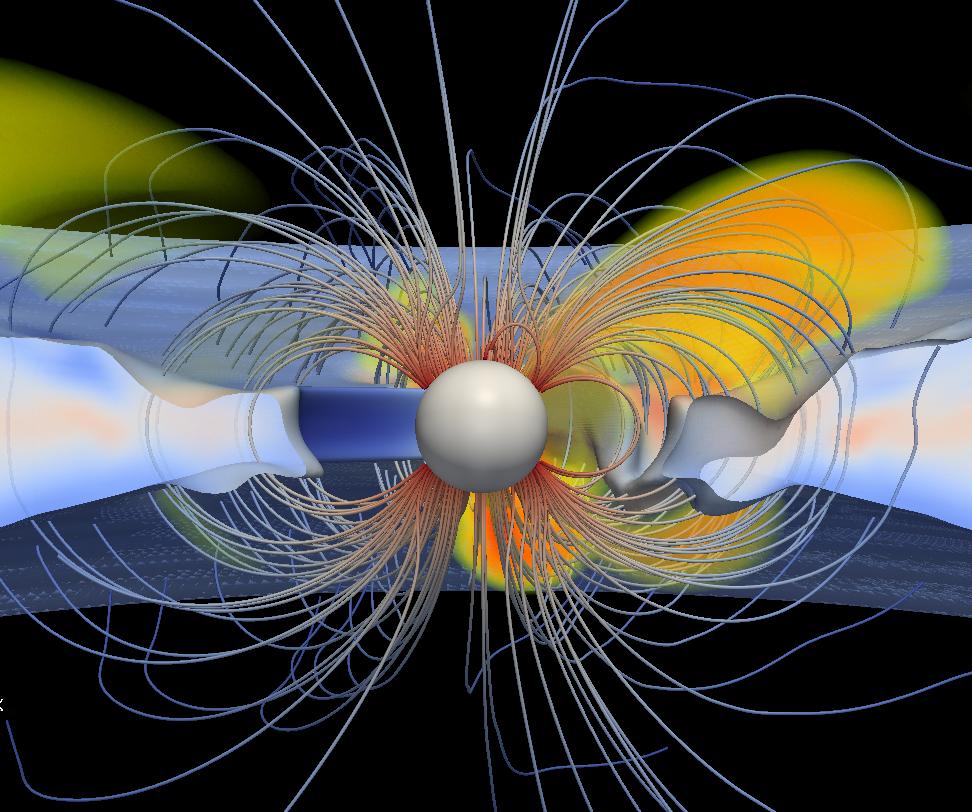 |
Evolution of protostellar jets and origin of their X-ray emission
|
Modeling of protostellar jets, aimed at investigating the origin of
X-ray emission originating from jets and how jets interact with other
protostellar components (circumstellar environment, disk, etc.) through
radiation and/or mechanical impact. This program is based on the FLASH
code; we performed extensive 2D hydrodynamic simulations, obtaining
substantial resources at CINECA. In two papers (Bonito et al. 2004,
2007), we investigated the origin of X-ray emission originating
from protostellar jets, explaining in a natural way, without any
ad hoc assumption, that this emission originates just behind the
interaction front of the jet with the surrounding medium. We have further
investigated the morphology and time variability of X-ray emission from
jets, modeling the interaction of jets with inhomogeneous surrounding
medium and considering pulsed jets instead of continuous jets (Bonito
et al. 2010a, 2010b).
|
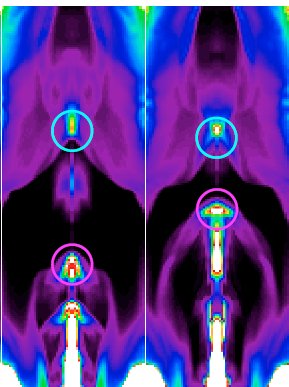 |
Evolution of nova outbursts
|
Three-dimensional Hydrodynamic modeling of the outburst of a nova
expanding through the highly inhomogeneous circumstellar medium (CSM),
aimed at investigating the role played by the inhomogeneous medium and
by different physical processes (thermal conduction, radiative losses,
etc.) in determining the shape an morphology of the nova remnant. The
pre-explosion system conditions includes the companion star and the
accretion disk around the white dwarf. The models have been used
to investigate three nova outbursts occurred in 2006 (RS Ophiuchi,
Orlando, Drake, & Laming 2009), and 2010 (U Scorpii, Drake & Orlando
2010; V 407 Cygni, Orlando & Drake 2012) through the comparison with
X-ray observations. In all the cases, the simulations have shown that
the inhomogeneous CSM can have a profound influence on the evolving
blast wave. In particular, the accretion disk around the white dwarf or
an equatorial density enhancement can determine a poleward hydrodynamic
collimation of the blast and of the ejecta, leading to a bipolar
X-ray emitting shell.
|
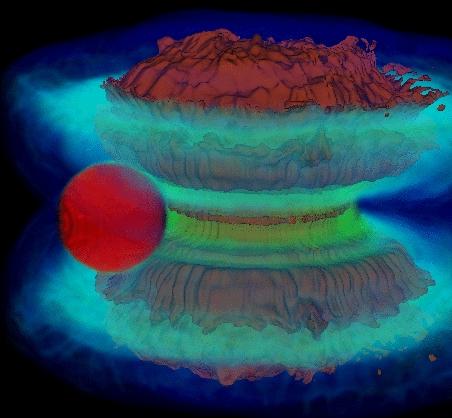 |
Interaction of supernova remnants with the surrounding environment
|
MHD modeling of supernova remnant (SNR) shocks expanding through a
magnetized inhomogeneous medium, aimed at investigating the physical
conditions leading to the complex morphologies of SNRs observed in the
X-ray band. This program is based on the FLASH
code; we performed extensive 2D and 3D hydrodynamic and MHD simulations,
obtaining substantial resources, including those of 2 key-projects,
at CINECA. We have studied the interaction of SNR shock waves with
inhomogeneities of the ISM (Orlando et al. 2005, 2006, 2008, 2010, Miceli
et al. 2006), with the aim to study the role of the physical processes at
work (e.g. magnetic-field oriented thermal conduction, radiative losses,
etc.), and to derive new diagnostics of the shock-cloud interaction.
We are studying the evolution
of a stellar fragment ("shrapnel") ejected in a supernova explosion
(Miceli et al. 2012, in preparation) with the aim to investigate how
the shrapnels modify the morphology and chemical composition of SNRs.
|
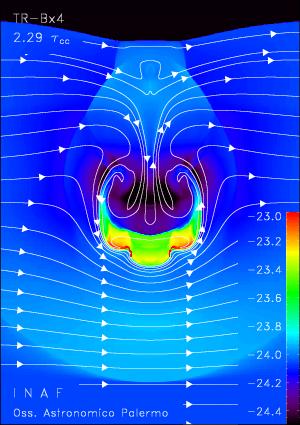 |
Effects of cosmic ray particle acceleration on the evolution of supernova remnants
|
We study the synchrotron radio, X-ray, and inverse Compton
gamma-ray emission originating at the shock front of SNRs (Orlando et
al. 2007, 2009, 2010); we have investigated the role of a non-uniform
interstellar medium (ISM) or of a non-uniform ambient magnetic field in
determining the asymmetric morphology of bilateral supernova remnants
(BSNRs) as observed in the radio (Orlando et al. 2007; Bocchino et
al. 2011) and in the X-ray and gamma-ray bands (Orlando et al. 2011).
|
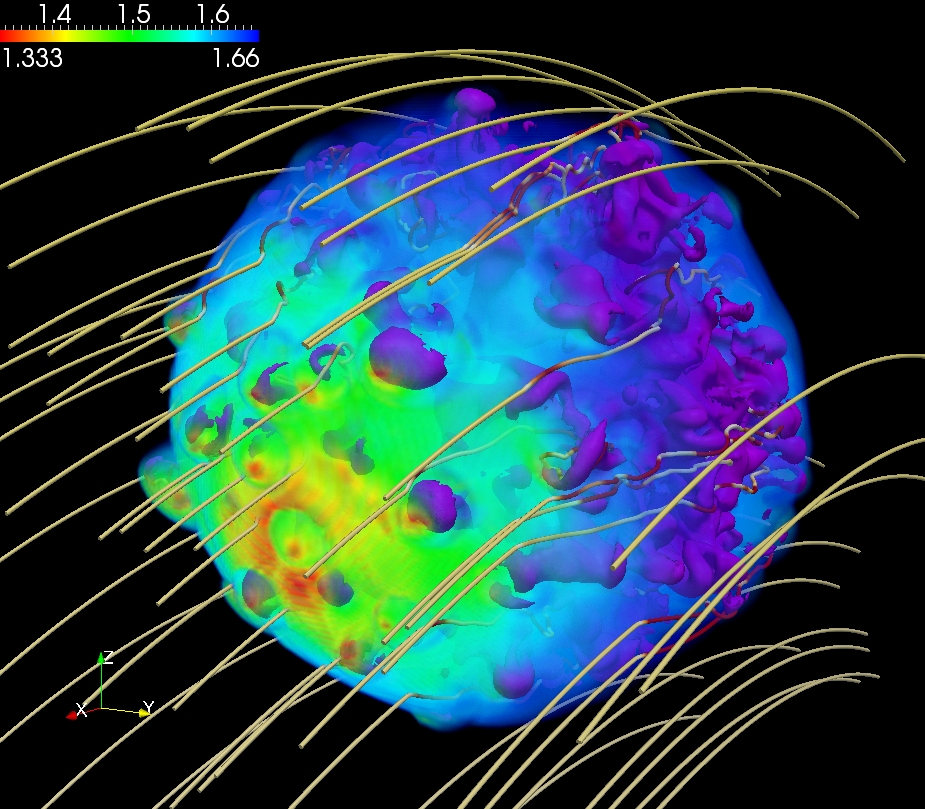 |
|
|
|